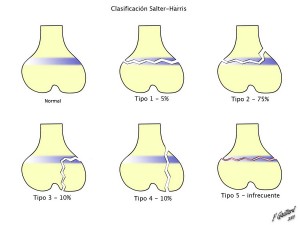Fractures
Fracture to call broken bone. There are many types of fractures. Healthy bones are very strong and able to withstand large forces, but subjected to excessive force may fracture.
The repair begins just after fracture, when cells start a series of processes of regeneration, to be supervised and directed to the healing It is adequate.
Bone healing may take a few weeks to a few months, depending on the type of fracture, where it is and if it is an open or closed fracture. It is important to maintain bone health through good nutrition, remedial exercise and sunlight dose.
A fracture is a break or a loss of continuity of a bone. Is caused by trauma, a direct blow to the indirect, as a torsion, avulsion (if force is made on the insertion of a tendon), o bien for fatiga (if force to the bone becomes prolonged and intermittent). We say that a fracture is open if the broken bone punctures the skin and no wound. If there is no wound or skin breakdown or damage any surrounding tissue, is called simple or closed fracture. Also, fractures can be partial or total. When the fracture is incomplete, and the fragments are not separated, fissure called.
Causes
Fractures are often the result of accidents, falls or sports injuries. They can also be caused by diseases as osteoporosis, bone-thinning or loss of bone mass.
Symptoms
Symptoms of a fracture may include:
- Severe pain.
- Inflammation
- Bruising, skin bruising or discoloration around the bones or joints.
- The affected limb is bent at an unusual angle.
- Hemorrhage, case of an open fracture.
- Numbness and tingling.
- Inability to move or bear weight on the affected limb.
- Grating sound or sensation in the bone or joint.
When someone breaks a bone can be pale and dizzy due to pain.
What to do?
Given a fracture, you need to seek medical help immediately. Fracture may be due or owed plaster splint applied. Sometimes you should use the surgery to put plates, nails or screws in order to hold the bone in place.
Unless absolutely necessary, should not move a person with a broken limb, until a medical professional has immobilized.
Diagnosis
The fractures were diagnosed by physical examination through which the doctor evaluates the general condition of the person and the extent of the injury.
And general, the diagnosis is confirmed by radiography, that provides clear images of the bone is broken and shows whether or not, where exactly the fracture and what type.
An MRI or a CT scan may also be required.
Treatments
The fracture treatment varies widely depending on the type of fracture, location, the degree of displacement of the bone and the patient's general condition. But either fracture, must always return the bone in place and prevent movement until healed. The repositioning of the bone in place may require anesthesia and surgery.
Immobilization
After placing the bone in place, the ends must be welded to be immobilized in the correct position.
For immobilization can be used:
- Yesos u ortesis (they are external devices that, in this case, immobilized until healed fractures).
- Plates and screws, using minimally invasive techniques.
- Intramedullary nails (which are internal steel rods) in the center of the long bones, as the femur and tibia.
- External Fijadores, metal or carbon fiber scaffold devices appear directly around the body and fastened to the bone through the skin.
The immobilization takes between two to eight weeks, Depending on the bone marrow and the complications that may occur.
- The majority of fractures heal successfully once the bone has been placed in its correct place and immobilized.
- Sometimes, when the bone has healed physiotherapy is needed to restore strength to the muscles and restore movement.
- When bones do not heal or heal slowly, can be used for ultrasonic therapy. The low-intensity ultrasound is applied to the area of the fracture.
- If the fracture does not heal, Sometimes a bone graft is needed.
Recovery
The healing process of a fracture requires time, rest and good nutrition is recommended. Fractures take time to heal depending on where the bone is broken and how severe the fracture is.
During his recovery the affected area tends to lose muscle strength. The doctor will recommend specific exercises to regain muscle strength, the flexibility and mobility of the joint.
Prevention
Loss of bone density is part of the natural aging process. From the 40, bones begin to lose density and the likelihood that a fracture occurs increase.
The bone health is largely determined by genetics, but also by other factors such as food, exercise, alcohol, body weight and smoking.
Importance of food
A diet rich in calcium is important for healthy bones. Sources of calcium are: milk, cheese, yogurt and vegetables. Vitamin D, found in eggs and fatty fish, helps the body absorb calcium.
Exercising
Bones become stronger and more dense if exercise is performed regularly.
It is particularly important for older people to remain active, to help reduce the risk of fractures.
Sunlight promotes the formation of vitamin D in the skin, which is necessary to maintain the health of bones.
During menopause
Postmenopausal, women produce less estrogen (which are female hormones that regulate the use of calcium).
It is very important for women to strengthen their bones before menopause.
Postmenopausal, the risk of osteoporosis can be reduced:
- sessions short and frequent practice exercises with dumbbells,
- stopping smoking,
- moderating alcohol
- sunbathing in moderation
- if you eat foods rich in calcium, found in vegetables like broccoli and peas and dairy products such as milk, cheese and yogurt.
Consult your doctor about the advisability of taking a supplement extra calcium.

